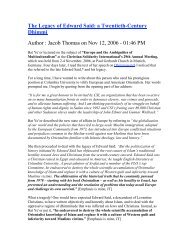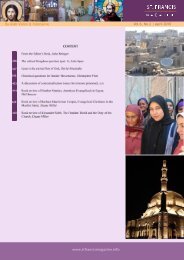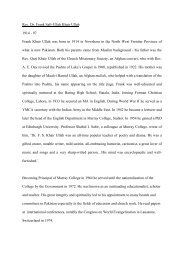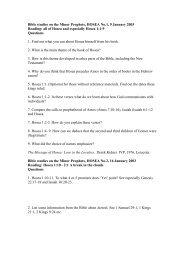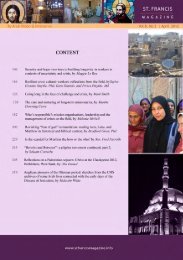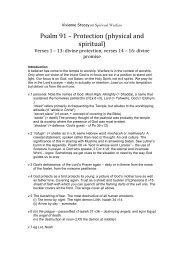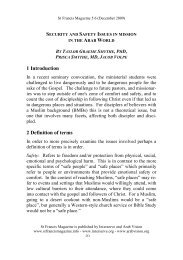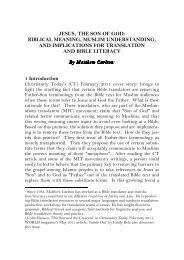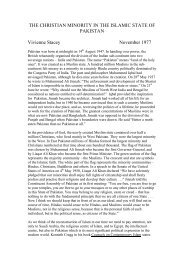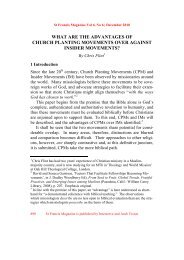download the pdf - St.Francis Magazine
download the pdf - St.Francis Magazine
download the pdf - St.Francis Magazine
Create successful ePaper yourself
Turn your PDF publications into a flip-book with our unique Google optimized e-Paper software.
<strong>St</strong> <strong>Francis</strong> <strong>Magazine</strong> Vol 8, No 4 | August 2012<br />
freedom of lifestyle which he saw Acts 15 as confirming. He proposed<br />
that missionaries and MBBs could adopt elements of Muslim<br />
lifestyle in an ‘incarnational’ manner which he viewed as analogous<br />
to Jesus and <strong>the</strong> apostles remaining Torah-observant Jews. This<br />
proposal also built upon claims that most Islamic forms, including<br />
those involved within <strong>the</strong> Five Pillars, were originally acquired<br />
from seventh-century Middle Eastern Jews and Christians (Woodberry<br />
1989, cited by Travis and Travis 2005: 398).<br />
This sense of a comparative cultural continuity which characterises<br />
C5 has been apparent in o<strong>the</strong>r proposals for it. Lewis (2004a),<br />
drew on Rodney <strong>St</strong>ark’s sociological analysis of early church growth<br />
(<strong>St</strong>ark 1996). He stressed cultural continuity, community involvement<br />
and open networks as factors facilitating rapid spread of <strong>the</strong><br />
gospel before later Constantinian regulation allegedly slowed such<br />
growth. The perceived danger with C4, despite its apparent avowal<br />
of cultural conformity, was that it would – over time – lead to distancing<br />
from <strong>the</strong> surrounding mosque-based culture. C5, however,<br />
utilising <strong>the</strong> gaps between personal commitment and official <strong>the</strong>ology,<br />
would allow some Muslims to remain within this culture (Travis<br />
and Travis 2005: 400-401, 405). Fur<strong>the</strong>rmore, C4 was assessed to<br />
have its own potential problems. These ranged from apostasy within<br />
congregations to negative responses from <strong>the</strong> society surrounding<br />
<strong>the</strong> congregation which might preclude C4 contextualisation<br />
from serving as a feasible way to plant new congregations (Brown<br />
2006d: 132). Several made use of Hiebert’s (1994) distinction between<br />
‘bounded’ and ‘centred’ sets and, judging salvation to involve<br />
a process, saw ‘directional’ faith within a process towards Christ as<br />
more significant than a static or binary ‘positional’ religion (Travis<br />
and Travis 2005: 407-408; cf. also DeNeui 2005; Kraft 2005b;<br />
Brown 2007b: 69). However, it would be inadequate to characterise<br />
C5 as only emphasising cultural continuity: simultaneously, it can<br />
also incorporate an understanding that growth in Christ might well<br />
include, and even require, decisive release and separation from spiritual<br />
bondage (Travis and Travis 2005: 408-409).<br />
In sum, <strong>the</strong>n, <strong>the</strong> underlying and intensifying question in this<br />
period was whe<strong>the</strong>r C5 was legitimate and sufficient in itself as a<br />
<strong>St</strong> <strong>Francis</strong> <strong>Magazine</strong> is a publication of Interserve and Arab Vision 476




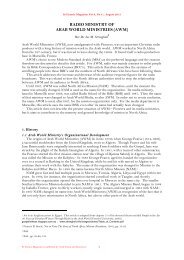
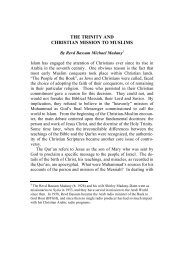
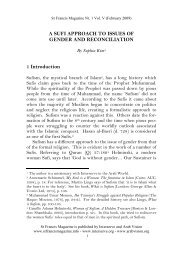
![Reflections on Surah Fatiha and the Lord's Prayer[1] - St.Francis ...](https://img.yumpu.com/49377951/1/184x260/reflections-on-surah-fatiha-and-the-lords-prayer1-stfrancis-.jpg?quality=85)
